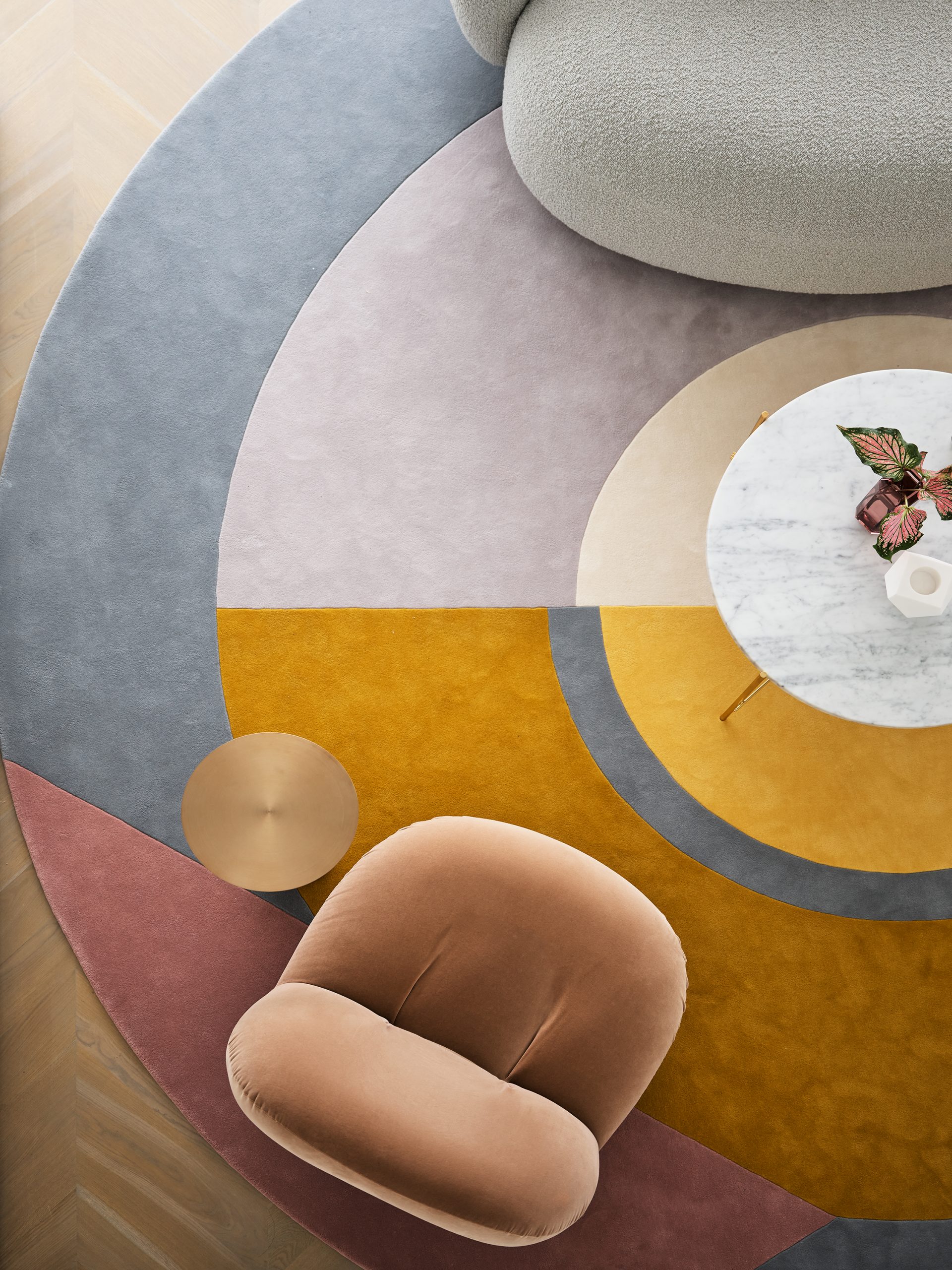European style inspires this Greg Natale designed Sydney home
French flair and a little femininity inform this harbourside home by award winning designer Greg Natale
In design circles, curves are often considered a gesture towards femininity. For designer Greg Natale, however, they are so much more. Moving beyond sharp angles and straight lines is an expression of movement and energy, while introducing a sculptural element to interior spaces.
Curves are an unexpected find in this penthouse apartment on one of the piers at Sydney’s Walsh Bay that features in Natale’s latest book, The Layered Interior. Once an industrial site characterised by practical, elongated ‘fingers’ jutting into the harbour, the piers were restored and repurposed in the 1990s, with a select few being converted into residences enjoying exclusive views of the waterways.
More than 25 years on from the conversion, Natale says the owners of this residence wanted a sophisticated, hotel-like experience that made best use of the space while being unapologetically warm and curvaceous.
“They wanted something that felt super light, really modern and very European,” he says. “She was looking at France (for inspiration), but modern French.”
The first obvious issue was the placement of the staircase, which was sitting in the middle of the two-storey void. Natale moved it to the side, to allow for better planning of the living area and to soften the edges of the solid white balustrade so that the staircase almost vanishes against the wall.
The penthouse needed to accommodate the owners and their two sons, who were living at home while completing university. The lower ground would provide accommodation for the young adults, along with a study and bathroom, while the open plan living area would be the centrepiece. While the curves are evident in their sons’ rooms, oak joinery and an integrated bedhead lends a slightly more masculine feel to the spaces.
Entry is via a formal reception area, with a deliberately lower ceiling to increase the sense of drama as guests step over the marble threshold and into the double height living space.
“The marble threshold is there to create a sense of arrival,” he says. “We have played with marble portals a lot – it’s a recurring theme.”
The dining room and kitchen continue the curved theme and are finished in the same refined palette of white walls, carrara marble and oak chevron floors along with the smallest touch of brass. While the house is furnished in tones of gold, grey and soft pink – including a spectacular circular rug from Natale’s range for Designer Rugs in the living room – he says it’s a surprisingly flexible space.
“The space is so neutral, someone could come in with their own furniture and put their stamp on it,” Natale says.
Upstairs, the drama continues with a master bedroom suite incorporating an open plan ensuite. Natale admits a bath and double vanity without walls is not everyone’s cup of tea.
“You have the master suite with an open bathroom for that hotel look,” he says. “I am not a fan of those kinds of hotels but the owner wanted that big open space and it’s amazing the sense of space you get with open bathrooms.
“You can create more interesting spaces.”
Natale also played with the ceiling shapes – another recurring theme in his work – to gently create zones and direct flow in the space.
“If a clean ceiling works, that’s fine, but having a white, boring, plain ceiling is not a considered space,” he says. “You should really look at the ceiling like a fifth wall.”
Indeed, every small aspect of this home has been considered to create the simplicity and sophistication the clients were seeking. But making everything look this clean takes enormous effort – and skill. The building was completely stripped back and replanned.
“It’s a highly detailed apartment, even though it looks very simple,” Natale says. “There are small details, like a brass strip along the shadowline between the skirting and the rest of the wall. We want everything to be considered – including the aircon.”
Pictures: Anson Smart
The Layered Interior, $110 published by Rizzoli. Order a copy here
See more stories like this in the first edition of Kanebridge Quarterly, out now
This stylish family home combines a classic palette and finishes with a flexible floorplan
Just 55 minutes from Sydney, make this your creative getaway located in the majestic Hawkesbury region.
As Paris makes its final preparations for the Olympic games, its residents are busy with their own—packing their suitcases, confirming their reservations, and getting out of town.
Worried about the hordes of crowds and overall chaos the Olympics could bring, Parisians are fleeing the city in droves and inundating resort cities around the country. Hotels and holiday rentals in some of France’s most popular vacation destinations—from the French Riviera in the south to the beaches of Normandy in the north—say they are expecting massive crowds this year in advance of the Olympics. The games will run from July 26-Aug. 1.
“It’s already a major holiday season for us, and beyond that, we have the Olympics,” says Stéphane Personeni, general manager of the Lily of the Valley hotel in Saint Tropez. “People began booking early this year.”
Personeni’s hotel typically has no issues filling its rooms each summer—by May of each year, the luxury hotel typically finds itself completely booked out for the months of July and August. But this year, the 53-room hotel began filling up for summer reservations in February.
“We told our regular guests that everything—hotels, apartments, villas—are going to be hard to find this summer,” Personeni says. His neighbours around Saint Tropez say they’re similarly booked up.
As of March, the online marketplace Gens de Confiance (“Trusted People”), saw a 50% increase in reservations from Parisians seeking vacation rentals outside the capital during the Olympics.
Already, August is a popular vacation time for the French. With a minimum of five weeks of vacation mandated by law, many decide to take the entire month off, renting out villas in beachside destinations for longer periods.
But beyond the typical August travel, the Olympics are having a real impact, says Bertille Marchal, a spokesperson for Gens de Confiance.
“We’ve seen nearly three times more reservations for the dates of the Olympics than the following two weeks,” Marchal says. “The increase is definitely linked to the Olympic Games.”

Getty Images
According to the site, the most sought-out vacation destinations are Morbihan and Loire-Atlantique, a seaside region in the northwest; le Var, a coastal area within the southeast of France along the Côte d’Azur; and the island of Corsica in the Mediterranean.
Meanwhile, the Olympics haven’t necessarily been a boon to foreign tourism in the country. Many tourists who might have otherwise come to France are avoiding it this year in favour of other European capitals. In Paris, demand for stays at high-end hotels has collapsed, with bookings down 50% in July compared to last year, according to UMIH Prestige, which represents hotels charging at least €800 ($865) a night for rooms.
Earlier this year, high-end restaurants and concierges said the Olympics might even be an opportunity to score a hard-get-seat at the city’s fine dining.
In the Occitanie region in southwest France, the overall number of reservations this summer hasn’t changed much from last year, says Vincent Gare, president of the regional tourism committee there.
“But looking further at the numbers, we do see an increase in the clientele coming from the Paris region,” Gare told Le Figaro, noting that the increase in reservations has fallen directly on the dates of the Olympic games.
Michel Barré, a retiree living in Paris’s Le Marais neighbourhood, is one of those opting for the beach rather than the opening ceremony. In January, he booked a stay in Normandy for two weeks.
“Even though it’s a major European capital, Paris is still a small city—it’s a massive effort to host all of these events,” Barré says. “The Olympics are going to be a mess.”
More than anything, he just wants some calm after an event-filled summer in Paris, which just before the Olympics experienced the drama of a snap election called by Macron.
“It’s been a hectic summer here,” he says.

AFP via Getty Images
Parisians—Barré included—feel that the city, by over-catering to its tourists, is driving out many residents.
Parts of the Seine—usually one of the most popular summertime hangout spots —have been closed off for weeks as the city installs bleachers and Olympics signage. In certain neighbourhoods, residents will need to scan a QR code with police to access their own apartments. And from the Olympics to Sept. 8, Paris is nearly doubling the price of transit tickets from €2.15 to €4 per ride.
The city’s clear willingness to capitalise on its tourists has motivated some residents to do the same. In March, the number of active Airbnb listings in Paris reached an all-time high as hosts rushed to list their apartments. Listings grew 40% from the same time last year, according to the company.
With their regular clients taking off, Parisian restaurants and merchants are complaining that business is down.
“Are there any Parisians left in Paris?” Alaine Fontaine, president of the restaurant industry association, told the radio station Franceinfo on Sunday. “For the last three weeks, there haven’t been any here.”
Still, for all the talk of those leaving, there are plenty who have decided to stick around.
Jay Swanson, an American expat and YouTuber, can’t imagine leaving during the Olympics—he secured his tickets to see ping pong and volleyball last year. He’s also less concerned about the crowds and road closures than others, having just put together a series of videos explaining how to navigate Paris during the games.
“It’s been 100 years since the Games came to Paris; when else will we get a chance to host the world like this?” Swanson says. “So many Parisians are leaving and tourism is down, so not only will it be quiet but the only people left will be here for a party.”
This stylish family home combines a classic palette and finishes with a flexible floorplan
Just 55 minutes from Sydney, make this your creative getaway located in the majestic Hawkesbury region.
























